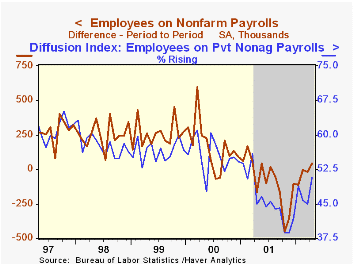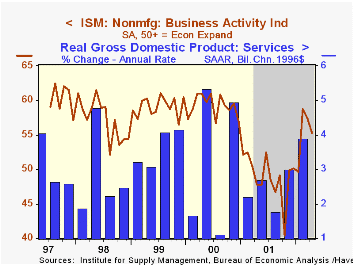 Global| May 03 2002
Global| May 03 2002April Job Rise Too Small to Keep Unemployment Rate from Rising
by:Tom Moeller
|in:Economy in Brief
Summary
The unemployment rate surged to the highest level since August 1994. Household employment rose a modest 82,000 (-1.1% y/y) but the labor force jumped 565,000 (0.6% y/y). Further indication of labor market weakness was the less than [...]

The unemployment rate surged to the highest level since August 1994. Household employment rose a modest 82,000 (-1.1% y/y) but the labor force jumped 565,000 (0.6% y/y).
Further indication of labor market weakness was the less than expected rise in nonfarm payrolls and the downward revision to March's previously reported gain.
Downward revisions to March employment were across the board in the service producing industries, but were large for basic services.
A glimmer of improvement was the rise in the one-month diffusion index for nonfarm payrolls. This breadth of change measure rose to 50.7, the first month above 50 since last March.
Factory sector jobs continued to fall, though job losses were most notable in the nondurable as well as transportation industries. The one month diffusion index for the factory sector improved to 47.1%, its highest level since July 2000.
Construction sector jobs fell for the third month this year.
Employment in the service sector rose 134,000 (0.1% m/m) due to small increases in several industries.
The index of aggregate hours worked (employment times hours worked) fell 0.2% and started 2Q below the 1Q average.
Average hourly earnings rose an expected 0.1% and March was unrevised.
The employment figures for nonfarm payrolls are based on reports provided to the US Labor Department by businesses, while the figures from which the unemployment rate is derived are based on a survey of US households.
| Employment | April | Mar | Y/Y | 2001 | 2000 | 1999 |
|---|---|---|---|---|---|---|
| Payroll Employment | 43,000 | -21,000 | -1.0% | 0.4% | 2.2% | 2.4% |
| Manufacturing | -19,000 | -38,000 | -6.6% | -4.2% | -0.5% | -1.3% |
| Average Weekly Hours | 34.1 | 34.2 | 34.2 | 34.2 | 34.4 | 34.5 |
| Average Hourly Earnings | 0.1% | 0.3% | 3.4% | 4.2% | 3.8% | 3.6% |
| Unemployment Rate | 6.0% | 5.7% | 4.5% | 4.8% | 4.0% | 4.2% |
by Tom Moeller May 3, 2002

The Institute for Supply Management business activity index of the nonmanufacturing sector fell to the low end of expectations last month.
New orders, employment and imports all rose. The not seasonally adjusted price index rose for the fourth month in a row to its highest level since last May.
Business activity for the nonmanufacturing sector is a question separate from the components mentioned above. In contrast, the NAPM manufacturing sector composite index weights the components.
During the last four years, there has been a 43% correlation between the level of the NAPM nonmanufacturing index and quarterly growth in real GDP in the service sector.
ISM surveys more than 370 purchasing managers in more than 62 industries, including construction, law firms, hospitals, government and retailers. The nonmanufacturing survey dates only to July 1997, therefore its seasonal adjustment should be viewed tentatively.
| ISM Nonmanufacturing Survey | April | Mar | Y/Y | 2001 | 2000 | 1999 |
|---|---|---|---|---|---|---|
| Business Activity Index | 55.3 | 57.3 | 47.8 | 49.0 | 59.2 | 59.1 |
Tom Moeller
AuthorMore in Author Profile »Prior to joining Haver Analytics in 2000, Mr. Moeller worked as the Economist at Chancellor Capital Management from 1985 to 1999. There, he developed comprehensive economic forecasts and interpreted economic data for equity and fixed income portfolio managers. Also at Chancellor, Mr. Moeller worked as an equity analyst and was responsible for researching and rating companies in the economically sensitive automobile and housing industries for investment in Chancellor’s equity portfolio. Prior to joining Chancellor, Mr. Moeller was an Economist at Citibank from 1979 to 1984. He also analyzed pricing behavior in the metals industry for the Council on Wage and Price Stability in Washington, D.C. In 1999, Mr. Moeller received the award for most accurate forecast from the Forecasters' Club of New York. From 1990 to 1992 he was President of the New York Association for Business Economists. Mr. Moeller earned an M.B.A. in Finance from Fordham University, where he graduated in 1987. He holds a Bachelor of Arts in Economics from George Washington University.






